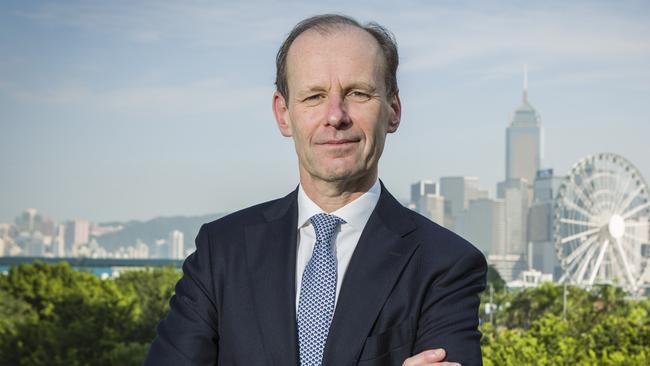ANZ full-year profit slumps on restructuring, one-off charges
ANZ’s full-year cash profit is down 18pc to a five-year low, as it unveiled plans to sell wealth operations in Australia.

ANZ’s full-year cash profit has slumped 18 per cent to a five-year low, weighed down by impairments and lower margins.
As it posted its full-year results, the bank further detailed plans to focus on its most profitable Australian and New Zealand operations, with activity underway to divest non-core wealth operations in Australia.
The bank (ANZ) also declared a dividend at the bottom end of expectations, as it takes a more cautious approach to payouts amid tighter capital requirements.
For the year to September 30, ANZ booked a 24 per cent drop in net earnings to $5.7 billion, while the more closely-watched cash profit number fell 18 per cent to $5.9bn.
The cash earnings figure came in shy of analyst projections for a reading of $6.07bn.
Adjusted pro-forma cash profit was down 3 per cent at $7bn, but the group’s profit before provisions rose 6 per cent in what it labelled a sign simplification benefits were emerging.
ANZ updated investors on a strategic review of its wealth arms in Australia and New Zealand, saying it would pursue divestments over the next 12 months, starting with its Australian life insurance, investments and advice and superannuation businesses.
“The strategic review of ANZ’s wealth businesses in Australia and New Zealand concluded that while the distribution of high quality wealth products and services should remain a core component of the group’s overall customer proposition, ANZ does not need to be a manufacturer of life and investments products,” the bank said.
“The initial focus will be on the Australian wealth business where ANZ is exploring a range of possible strategic and capital market options that will maintain strong outcomes for customers.”
The New Zealand wealth business will be considered separately in 2017, ANZ said.
The announcement comes just days after it offloaded its retail and wealth businesses in five Asian markets.
It is another example of recently-appointed chief executive Shayne Elliott’s push to restructure operations, with $1.08bn in charges recorded through the fiscal year as he reshapes the way ANZ operates.
ANZ said earlier this month it would book a further $360 million in charges for the second half of the financial year for restructuring and a change in valuation for derivative instruments.
That came on top of $717 billion in charges taken in the first half, including for the sale of its Esanda vehicle-finance operation, restructuring and an adjustment to its valuation of minority investments in Asia.
The bank’s total provision charge for the year surged 62 per cent to $1.96bn, with expectations this number will remain “broadly the same” in the coming financial year as the end of the mining boom continues to weigh on some regions.
The charge equates to a loss rate of 34 basis points, with the bank noting a controversial settlement with Indian businessman Pankaj Oswal and his wife Radhika accounted for 3 bps.
“While in aggregate the credit environment is broadly stable, pockets of weakness continue to work their way through the economy, largely reflecting stress moving through the resources and resources related sectors,” ANZ said.
“The stress appears to have now largely passed through the institutional market and is progressively moving through the commercial and retail sectors.”
ANZ noted a modest pullback in its net interest margin to 2 per cent, from 2.04 per cent through the year as competitive pressures took a toll.
It also detailed a tier-one capital ratio of 9.6 per cent as at September 30, comfortably meeting current regulatory requirements.
“This year we delivered another good performance in Australia and New Zealand with our consumer and small business franchises producing strong results based on a disciplined approach to market share and tight cost management,” Mr Elliott said.
“We also took steps to create a better experience for our customers and to compete efficiently in the digital age. This included the successful launch of Apple Pay and Android Pay in Australia and Apple Pay in New Zealand.”
Mr Elliott offered little insight into the outlook for the year ahead, only noting the changes made through 2016 should start to improve momentum in its remaining operations.
“We are pleased with the initial progress that has been made this year in reshaping our strategy and setting ANZ on a path towards a sustainable improvement in customer outcomes and shareholder returns,” he said.
“Importantly we have the organisation aligned and we have established momentum in relation to the work that still needs to be done. This sets us up well to increase the pace of execution in 2017 and to deliver a better bank for customers and for shareholders.”
A cultural shift had taken place in the bank to better align with customers, Mr Elliott added, although he noted constant negative commentary around the profits of the big banks and ongoing calls for a royal commission showed the financial sector needed to make further improvements.
“We are also making changes to ensure we are fairer and more balanced in the way we deal with customers and to demonstrate our commitment to community responsibility,” he said.
“The current discussion about the banking sector in Australia however shows that we still have more to do to shift our culture and evolve the way we do business.”
ANZ declared a final dividend of 80c a share, in line with the bottom-end of guidance for the final dividend to “at least match” the interim payout. It fell short of expectations for a 90c per share dividend.
The decision brings full year dividends to $1.60 a share, 12 per cent below last year’s corresponding number.




